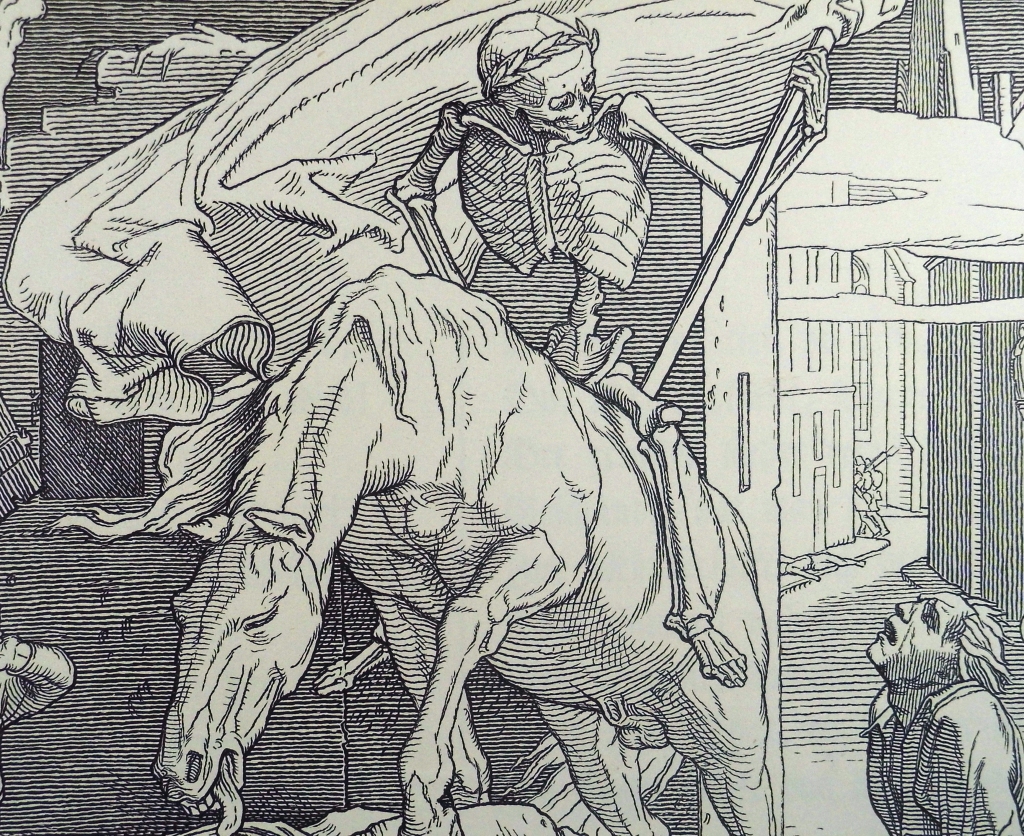
Triumphant Death, holding aloft the revolutionary red flag, surveys the dead and dying. Detail from plate 6. (Sp Coll Gemmell Add. f12)
Just in time for Halloween we are pleased to announce a spooky new addition to our Gemmell Collection of “Dance of Death” books, the appropriately titled Auch ein Totentanz (i.e. Yet Another Dance of Death). The Dance of Death is an artistic genre born in the late medieval period which incorporated images of Death, personified as a skeleton, leading people (sometimes dancing) to their death. It played on the idea that life is fleeting and temporary and that, regardless of rank or station, we all die.
Our latest acquisition is certainly not medieval though. Produced in the mid nineteenth century by German artist Alfred Rethel (1816-1859) with accompanying verse from Robert Reinick (1805-1852) Auch ein Totentanz recalls the earlier Dance of Death genre (particularly Hans Holbein’s version) but updates it to the nineteenth century. It takes the form of a highly politicised series of six woodcuts illustrating the danger of revolution. Popular uprisings and democratic revolutions spread across Europe during 1848 and this series was apparently conceived in response to the revolutionary sentiment, particularly perhaps the May 1849 uprising in Dresden, where the artist was resident.1 The series seems fundamentally conservative and anti-revolutionary in nature with the figure of Death deliberately misleading the working people into believing that they are righteously aggrieved, agitating them to rebel, then leading them to the barricades and their death in a hail of bullets. Despite some scholars now arguing that this counterrevolutionary message was not the artist’s intention, the series was apparently wildly popular with conservatives and those opposed to revolutionary republicanism and it was reprinted in huge numbers across Europe and was even used in schools as a warning to children against radicalism.2
The story told by Auch ein Totentanz is roughly as follows: Death, wearing what readers would recognise as the tell-tale style of coat and hat of a revolutionary radical, is seen riding into a small German town. He sets up a stall in front of a tavern. A poster on the tavern wall bears the revolutionary slogan “Freiheit, Gleichheit, Brüderlichkeit” (i.e. Liberty, Equality, Fraternity). By holding the wrong part of the scales of justice Death proceeds to “con” the populace into believing that a worker’s clay pipe weighs the same as the king’s crown. He then leads the people to rebel , brandishing a sword labelled “Volks iustiz” (People’s Justice) before proceeding to the barricades where he holds the red flag aloft and watches on as the workers are shot to death by the army. The series ends with Death on horseback, crowned with triumphant laurels, surveying the carnage, accompanied by the text “Als Brüder alle, frei und gleich” (i.e. All as brothers free and equal) linking the revolutionary slogan of earlier with the traditional Dance of Death theme of equality in death.
You can read more about the Dance of Death on our web pages.
References
1 Albert Boime (1991) “Alfred Rethel’s counterrevolutionary death dance” Art Bulletin 73, 4.
2 Peter Paret (1986) “The German revolution of 1848 and Rethel’s Dance of death” Journal of Interdisciplinary History XVII, I; and Paul Goldman (2012) Reading Victorian illustration, 1855-1875, Spoils of the Lumber Room (Farnham: Ashgate, 2012) p. 46; for an alternative views see Albert Boime (1991) “Alfred Rethel’s counterrevolutionary death dance” Art Bulletin 73, 4.
Categories: Archives and Special Collections, Library
 Johnny Beattie: ‘The Clown Prince of Scotland’
Johnny Beattie: ‘The Clown Prince of Scotland’  Lou and Kitty: a friendship in letters
Lou and Kitty: a friendship in letters  Preserving History: Challenges of Storing Old Beer Bottles and Cans in Archives and Special Collections Storage
Preserving History: Challenges of Storing Old Beer Bottles and Cans in Archives and Special Collections Storage  Eddie and the Library Angel: Ukrainian Poetry in the Edwin Morgan Archive
Eddie and the Library Angel: Ukrainian Poetry in the Edwin Morgan Archive
Leave a comment